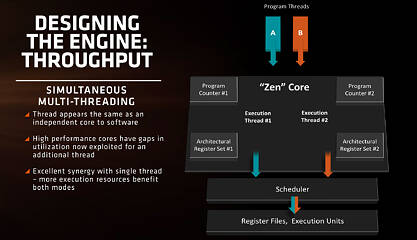 99
99
AMD Ryzen 9 3900X, SMT on vs SMT off, vs Intel 9900K
Test Setup »Introduction

The AMD Ryzen 9 3900X is the most powerful mainstream-desktop processor you can buy right now, and our comprehensive review of the chip shows it blow the competition to smithereens when it comes to multi-threaded tasks that can scale across multiple cores. It also performs very close to Intel's offerings at gaming.
Although over the past decade games have grown to leverage multi-core processors better, they still don't need HEDT-like core counts. "Battlefield V," for instance, was coded to leverage up to 12 logical processors. "Metro Exodus" and "Assassin's Creed Odyssey" can scale across a few more cores. There still remain games that don't need too many cores and benefit simply from high CPU clock speeds or IPC. This is probably why Intel didn't bother giving most of its desktop processors HyperThreading. The 6-core/6-thread Core i5-9600K is still being marketed as a gamer's CPU.

The Ryzen 9 3900X, thanks to SMT, or simultaneous multi-threading, can give your machine 24 logical processors, or threads. Identical in concept to Intel's HyperThreading, SMT treats each physical CPU core as two logical processors, so its machinery can be more optimally utilized. In theory, though SMT or HTT adds to the processor's power draw, latencies can pose compatibility issues with certain older software, or software that isn't coded too well to use it.
Nearly all PC platforms designed for multi-core processors offer two important settings in their BIOS setup programs: the ability to disable SMT or HTT and the ability to disable cores within a multi-core processor. These two settings come in handy for compatibility or troubleshooting, especially if you're a software developer trying to optimize or test your code. For most people, the settings don't make much sense, and so motherboards by default enable SMT/HTT on processors that feature it.
With a physical CPU core count as high as 12, we wondered how disabling SMT impacts the performance of a Ryzen 9 3900X and whether the processor in any way benefits from its disabling for certain kinds of applications or games. When you disable SMT, you shave off half the number of logical processors your operating system's scheduler has to address. Every processor it dispatches work to is guaranteed to be a full physical core with its L1/L2 caches, and integer and FPU pipes are fully dedicated to that workload. In theory, this should benefit software that don't scale across too many logical processors. Each core's scheduler isn't juggling resources between two threads, and so latencies should also be down.
In this review, we test a Ryzen 9 3900X with SMT disabled, making it a 12-core/12-thread processor. The processor is put through our entire CPU test bench and a number of games. We explore whether the 3900X with SMT disabled can be a viable daily-use solution for high-end gaming PC builds in which the user is more focused on gaming and light productivity. We are testing two theories: the extent of performance loss in multi-threaded tests and performance gain (if any) in tests that aren't too parallelized.
Jul 15th, 2025 16:27 CDT
change timezone
Latest GPU Drivers
New Forum Posts
- No offense, here are some things that bother me about your understanding of fans. (145)
- Stupid things one has done with hardware (65)
- RTX 5070 discussion (11)
- I would give anything for Valve's Steam to have an option to disable the Big Picture Mode button. How many times have I accidently clicked it, fml (52)
- Choosing the right motherboard (6)
- Solidigm NVMe Custom Modded Driver for All NVMe Brands SSDs & Any NVMe SSDs (229)
- Recommend me a decent budget card :) (33)
- What's your latest tech purchase? (24278)
- TOS 6 on Ugreen NAS (0)
- Folding Pie and Milestones!! (9620)
Popular Reviews
- MSI GeForce RTX 5060 Gaming OC Review
- Our Visit to the Hunter Super Computer
- Lexar NM1090 Pro 4 TB Review
- SilverStone SETA H2 Review
- NVIDIA GeForce RTX 5050 8 GB Review
- Fractal Design Epoch RGB TG Review
- Sapphire Radeon RX 9060 XT Pulse OC 16 GB Review - An Excellent Choice
- AMD Ryzen 7 9800X3D Review - The Best Gaming Processor
- Upcoming Hardware Launches 2025 (Updated May 2025)
- Corsair FRAME 5000D RS Review
TPU on YouTube
Controversial News Posts
- Intel's Core Ultra 7 265K and 265KF CPUs Dip Below $250 (288)
- Some Intel Nova Lake CPUs Rumored to Challenge AMD's 3D V-Cache in Desktop Gaming (140)
- AMD Radeon RX 9070 XT Gains 9% Performance at 1440p with Latest Driver, Beats RTX 5070 Ti (131)
- NVIDIA Launches GeForce RTX 5050 for Desktops and Laptops, Starts at $249 (122)
- NVIDIA GeForce RTX 5080 SUPER Could Feature 24 GB Memory, Increased Power Limits (115)
- Microsoft Partners with AMD for Next-gen Xbox Hardware (105)
- Intel "Nova Lake‑S" Series: Seven SKUs, Up to 52 Cores and 150 W TDP (100)
- NVIDIA DLSS Transformer Cuts VRAM Usage by 20% (99)

